THE BSA EXPERIMENTAL RIFLE 7.62 mm L1A1 .22RF CONVERSION
and the L12A1 adapter unit
plus contemporary write-ups on the introduction of the SLR service rifle and SLR competition rifle in the U.K.
See also the SLR L1A1 with SUIT sight..........the SLR L1A1 with IWS sight........and the SLR L1A1 SAWES Laser Training System.
The Birmingham Small Arms Company prototyped
a sleeved version of the L1A1 in .22-inch rimfire calibre.
The system employed could be construed as being a latter-day equivalent
of the late Ninteenth Century "Morris or Aiming Tube"
used, in one guise or another, in almost every British Service longarm since that time.
The images on this page are by courtesy of the Trustees of the Enfield (M.O.D.) Pattern Room Collection -
late of the R.S.A.F. ( Royal Small Arms Factory),
Nottingham, and now gifted to the Royal Armouries Museum at Leeds.
The collection still continues as a working reference library for Small Arms of the World
and maintains its acquisitive remit to that end.

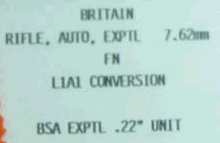 The Pattern Room tag, left, identifies the rifle,
The Pattern Room tag, left, identifies the rifle,
and the fore-end woodwork marking, right,
gives the year for the parent arm, 1959.


BSA's conversion of the L1A1 did use a removable tubed sleeve akin to
the later Heckler and Koch L12A1 conversion unit shown later in the page,
but included disabling of the full-bore gas operation system,
which precluded easy reconfiguration of the modified rifle to its original format.
The .22RF barrel sleeve is considerably shorter than the 7.62mm parent barrel;
probably just adequate for short range use up to around 25 yards,
especially if compared with the barrel length of a .22RF target pistol.
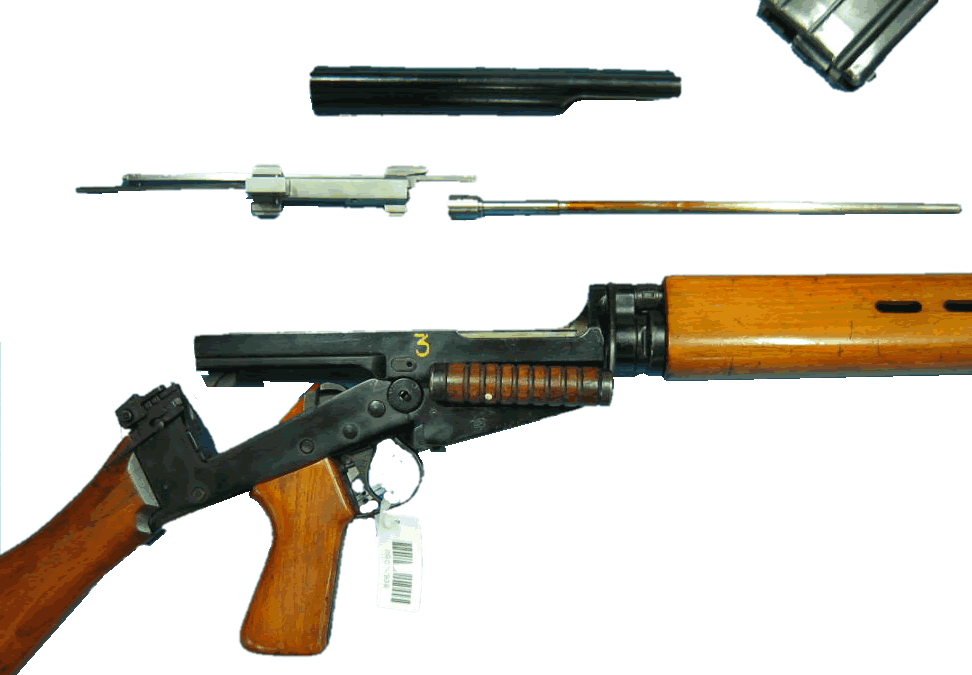
The markings on the side of the action body show the original calibre barred out
and ".22LR" (for the Long-Rifle cartridge) overstamped.
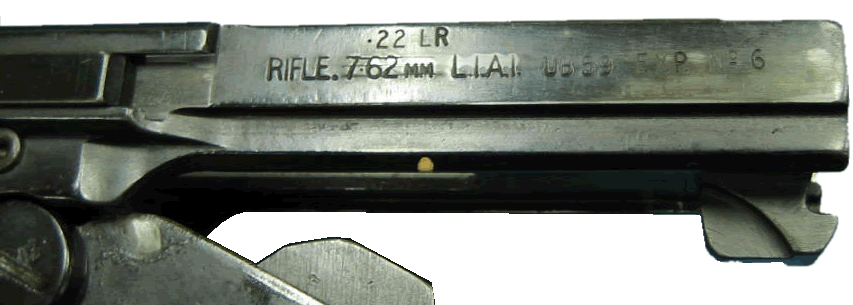
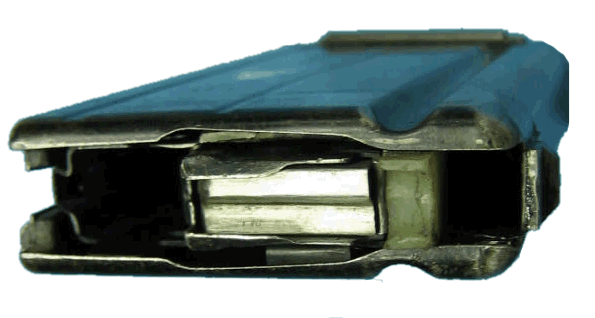
The rifle carries the designation "E.X.P. No 6" alongside the manufacturer and year code " UB59".

The .22RF magazine has a stepped feed platform to permit staggered loading of the rim-fire round,
maximising capacity as in the full-bore version.
The breech-block is below shown almost engaged with the breech-end of the inserted .22RF barrel sleeve.
The rim-fire case extractor lever can be seen protruding forward into
the machined bevelled slot in the breech chamber reinforce section which,
in a manner akin to the barrelling of the Rifle No.8 ,
itself protrudes rearwards into the receiver,
here a necessity due to the fitment of the .22RF chambered section
into the chamber of the 7.62 mm full-bore chamber.
(With the No.8 rifle this was done solely to shorten the bolt travel).
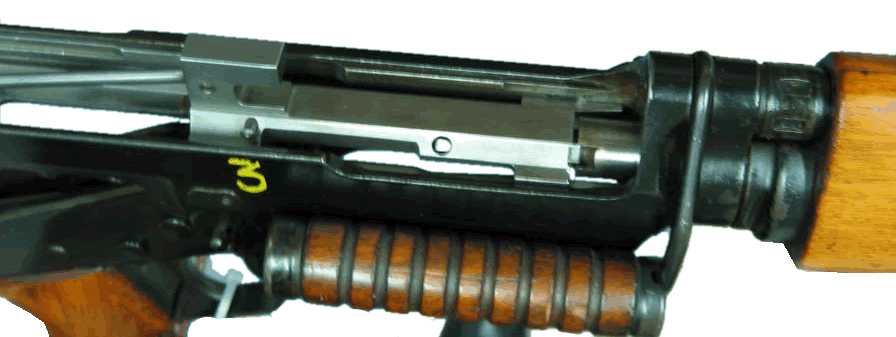
The replacement rim-fire breech-block is shown separately below

The example below is the full-bore service L1A1 rifle fitted with the
Heckler & Koch L12A1 .22RF (rim-fire) conversion kit and a muzzle extension tube which,
affixing to the bayonet lugs, covers the slots of the muzzle flash-hider.
This extension was apparently originally intended to limit any unwanted gas-flow effects
when the low-energy rimfire round was fired through the full-bore muzzle arrangement.
However, it was not included in the production conversion kit.
CLICK ON THE ABOVE IMAGE TO VIEW CONTEMPORARY VIDEO
OF
The Pattern
'14 No.3 Rifle, the SMLE
No.1 Rifle and No.2
Rifle, the No.4 Rifle and the FN-SLR Rifle
plus the EM2 Bulldog precursor to the current SA-80 Rifle,
and Service Rifle Target shooting at BISLEY CAMP RANGES Post WWII
The L12A1 kit, whilst officially notated as a conversion unit,
might more properly be described as an adapter unit,
since a conversion would more usually be expected to be a non-reversible modification.
Such semantics justify, earlier on this page, our description, as a 'conversion',
of the original experimental modification by B.S.A. (the Birmingham Small Arms Company),
of one their own licensed production SLR rifles, to .22RF calibre.
This conversion could not be returned to its full-bore service configuration by simple removal
of replacement adapted parts, as is the case with the rifle here shown.
Below, we illustrate the rifle broken to facilitate the fitting or removal of the adaptation components.
The standard top-cover lies upper left in the display,
with the rim-fire breech-block arrangement beneath it.
To the right of the breech-block, and in line, is the .22RF barrel sleeve
with its chamber section which engages with the 7.62 mm cartridge chamber of the parent arm.
This is the modern equivalent of a system devised more than a century earlier;
namely the Morris and Aiming Tubes used with the Martini and Lee-Enfield rifles
of the late 19th. and first half of the 20th. Centuries.
Indeed such sub-calibre tubed sleeves preceded these for the
breech-loading Snider Enfield and other similar longarms!
The magazine, converted to accept and feed the .22 rimfire round,
lies at the top right; two of these were supplied with each kit.


Below are copied the pages of the manual issued with the conversion kit,
which manual gives a brief specification plus fitting and maintenance instructions for the unit.
Images by courtesy of the trustees of the Enfield Pattern Room Collection.

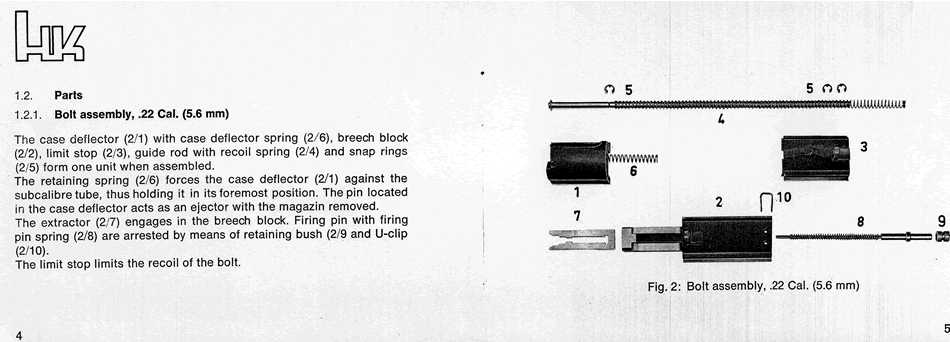




It will been noted that the H & K unit, with a full-length barrel sleeve,
could be expected to shoot reasonably accurately at up to 100 yards range.
The Warminster Collection holds an explanatory cutaway model of the .22 magazine.
 ..........
.......... 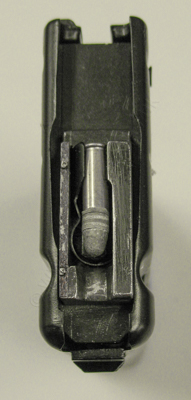 ...........
........... 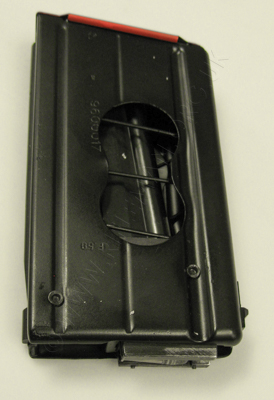
A full-bore competition version of the FN SLR was being marketed by Parker-Hale in the late 'Sixties'
THE F.N. LIGHT AUTOMATIC RIFLE
CAL. 7.62 mm. (.300)
" COMPETITION " MODEL

Above is illustrated the original Belgian F.N. rifle that has been adapted
for military use,
with only minor modifications, by all European NATO countries.
It is not available for commercial sale for in its military form it contravenes the regulations of most countries,
being a prohibited weapon by virtue of its feature of fully automatic operation at a single pull of the trigger.
For Target practice or Police use the trigger mechanism of the " COMPETITION " Model
is modified enabling the rifle to be used as a self loader,
i.e. with the magazine loaded a single shot will be fired at each trigger pull
until the magazine is emptied, when an automatic device operates to hold the breech open.
The weapon is gas operated with an adjustable regulator
to ensure certainty and smoothness of operation without excessive recoil.
The bolt is mechanically locked before firing can take place and is not unlocked until the bullet has left the barrel.
The bolt is in the forward position when the trigger is pressed which avoids disturbance
due to a more or less heavy mass moving forward at the moment of firing.
After firing the mechanism extracts the fired case and feeds a new cartridge
into the chamber as long as there are any cartridges in the magazine.
When the magazine is empty, the bolt remains to the rear,
indicating to the firer that the magazine needs refilling.
Magazines are provided to hold either 10 or 20 cartridges.
A folding carrying handle is convenient for transporting the weapon at the trail position.
SPECIFICATION:
Calibre: 7.62 m/m (.300")
Barrel length: 24"
Overall length: 44" approx.
Weight, magazine empty: 10 lbs. approx.
Sights: Aperture rear sight graduated up to 600 yds.
Blade foresight with protectors is mounted on gas cylinder.
List No. 3190
AMMUNITION
The rifle is designed for the NATO Service Cartridge of calibre 7.62 m/m
(.300").
The commercial equivalent of this cartridge is designated .308" Winchester
of which several well known brand makes, including
Swedish NORMA, are readily available.
Here is a Pathe News video covering the introduction of "The New Rifle" - the FN SLR L1A1
Other videos are available from our Enfield Video Page
With the introduction of the new British service rifle in 1954,
the U.K. NRA published a short article in its journal to give basic detail of
the replacement for the Lee-Enfield No.4 Rifle
with the first general issue automatic assault rifle to serve with British Forces
The Belgian Fabrique Nationale designed L1A1 SLR - The New Rifle - NRA Journal 1954
As a searchable flip-page facsimile
View another flip-page facsimile of the L1A1 SLR Armourers' Training Manual of 1961
and another of the L1A1 and L12A1 conversion unit Parts List with exploded drawings
There was also a comprehensive American SMALL ARMS REVIEW magazine article
originally published in the August edition of 2004
In 1960, Guns Review magazine published an article on the then
"New SLR competition rifle"
